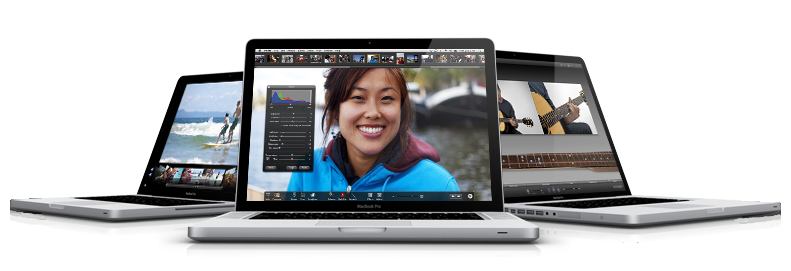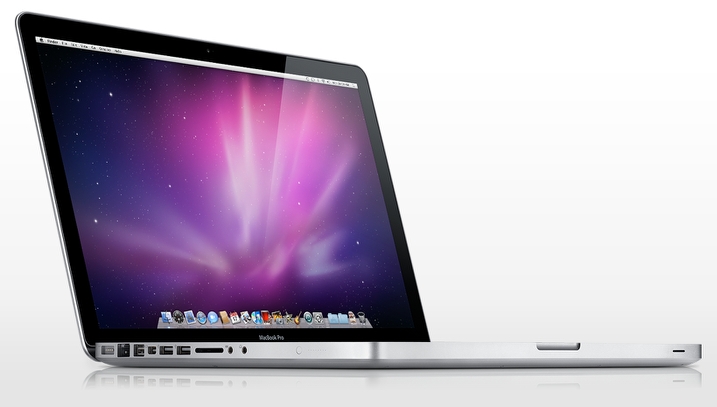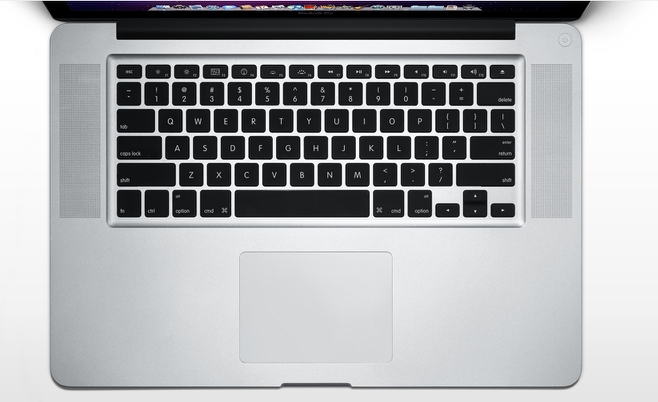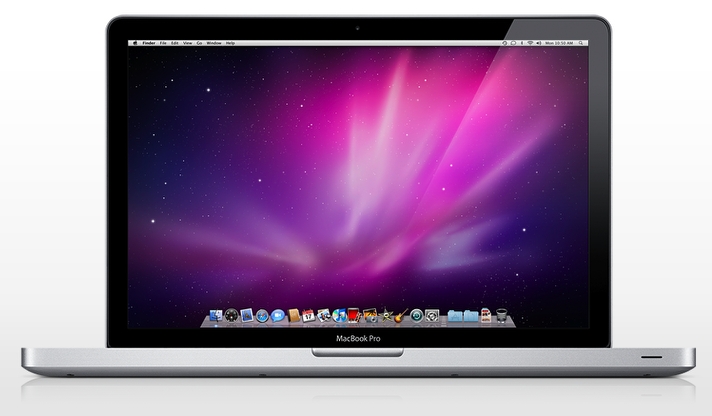New MacBook Pros = Solid Value and Performance Enhancement + Some Puzzlements Explained - The ‘Book Mystique
Wednesday, April 21, 2010
by Charles W. Moore
It’s been a week and a day since Apple unveiled the long and impatiently awaited MacBook Pro refresh, and after spending the last several months dyspeptically grumbling about my underwhelmedness with the iPad, it’s profound pleasure to be able to comment positively on some new Apple hardware.
After digesting the details for a week, I’m actually more than “positive” about the new MacBook Pros, more like (almost) unreservedly enthusiastic. It helps that the aluminum unibody MacBooks are IMHO the finest Apple system designs since the PowerBook G3 Pismo of ten years ago, and maybe the best ever, so this latest upgrade amounts to a bonus layering of value and performance enhancement on already superb machines.
Ad: Compare prices on MacBook Pros at MacPrices.net. New models are in stock today for up to $250 off MSRP! Price trackers updated daily.

Photo Courtesy Apple
Even my now more than a year old 13” MacBook -- the most humble and modest of all aluminum unibodies, remains an almost unalloyed delight with ample performance for my needs and so far anvil-like reliability. There are a few niggles, most of which were addressed with the subsequent promotion of the 13” model to full “Pro” status, but I’m a very happy camper, at least in OS X 10.5 Leopard. I finally got around to installing Snow Leopard last weekend, on my hard drive’s second partition so I didn’t burn my bridges to Leopard, and I’m glad I didn’t, but that’s a topic for another day. Back to the new MacBook Pros.
13 Inch MacBook Pro Passed Over For Core “i” Upgrade
There’s a bit of disappointment that the 13-incher, which remains my favorite form factor of the three MacBook Pros, got passed over for an upgrade to Core “i” processor power in this latest refreshment, but viewed realistically, I don’t imagine many folks would choose a 13” laptop as a video editing or serious gaming platform anyway. Even my MacBook’s 2.0 GHz Core 2 Duo is plenty lively, and the latest iteration gets Nvidia’s new GeForce 320M integrated graphics chipset, claimed to be up to 80 percent faster than the GeForce 9400M unit it replaces, which was no slouch itself. Incidentally, that 320M chipset is reportedly a custom unit created by Nvidia exclusively for Apple, and so far available only in the 13” MacBook Pro.
Ars Technica’s Chris Foresman has explained in great detail why the 13” MacBook Pro still has a Core 2 Duo CPU while its larger siblings got Core i5 and i7 silicon that offers clear performance advantages.
The broad strokes boil down to what I had suspected all along, ergo; there was no room (and probably not the pricing latitude either) to include a discrete graphics processor unit in the 13” MBP housing to supplement the Core “i” chips’ Intel (highly) integrated graphics, and going that route would have imposed too great a performance compromise compared with the Nvidia 48-core GeForce 320M chipset, or for that matter even the 16-core GeForce 9400M chipset of the preceding 13” Pro model, and Intel does not as yet (and may never) license Nvidia to produce graphics chipsets for use with Core “i” series processors.
Foresman says that while Apple could’ve gone with Intel’s Core i3 processors, they don’t support the Turbo Boost feature included with Core i5 and i7, and although the i3 does support hyper-threading, the 45nm 2.4GHz and 2.66GHz Core 2 Duo chips that Apple settled on are cheaper and offer 90 percent of the performance of comparable 32nm Core i3s, albeit with a tariff of higher power consumption, and graphics performance would’ve been significantly diminished by relying solely on the Core i3 or i5’s Intel HD integrated graphics processor, with NVIDIA claiming that even the 16-core 310M on which the Apple-only 320M is based is 10x faster than the Intel HD IGP, and there’s no room on the 13” MacBook Pro logic board for a discrete GPU to facilitate that workaround even if the expense were not an issue.

Photo Courtesy Apple
With the new 15” and 17” MBPs, graphics support configuration gets more complex, since all the larger models now all come with both integrated graphics and a discrete graphics processor unit -- Intel’s HM55 Express chipset and Nvidia’s GeForce 330M GPU respectively. One advantage the HM55 does enjoy is that it powers down when the discrete GPU is active, but I infer that Apple would’ve preferred to use the substantially higher-performance Nvidia 320M integrated graphics and was stymied by Intel’s balking at licensing Nvidia to make and sell chipsets for their Core “i” CPUs. Multilateral wrangling over that issue may help explain why it took Apple nearly four months longer to get Core “i” laptops into consumers’ hands than much of the Windows PC competition did.
Restoration of the discrete GPU feature to the base 2.4 GHz 15” MacBook Pro both explains and justifies a $100 price hike for that model (from $1,699 to $1,799), and I imagine few would argue that the hundred bucks worth of extra value is amply there, bolstered by the upgrade to Core i5 power.
Graphics Mode Switching On The Fly
A new enhancement on the dual graphics mode models is that they now automatically switch on the fly between the power-economizing integrated HM55 Express chipset and the discrete 330M GPU with its 48 Core architecture and 256 MB or 512 MB of dedicated VRAM, based on graphics processing demand. It can optionally be locked in discrete processing mode, but unfortunately not for integrated graphics only, although that’s sort of a nitpicky gripe.
The Core i5 and i7 CPUs in these new models have the same or lower nominal clock speeds as the Core 2 Duo silicon they replace, but the slowest Core i5 faster than the fastest Core 2 Duo processor despite running at a lower clock speeds (2.40GHz vs 3.06GHz) due to enhanced internal efficiency. The Core “i” chips’ “Turbo Boost” feature can also provide shortish bursts from the nominal 2.66 GHz to 3.06 GHz for intensive dual core tasks, and up to 3.33 GHz for single core tasks.
It should be noted that unlike the quad-core Intel i5 and i7 desktop processors found in Apple’s iMac, the mobile i5s and i7s in the new 15 and 17-inch MacBook Pros are not quad-core but rather two-core processors, but include Intel’s “Hyper-Threading” technology that allows them to run four virtual threads. The Mac Observer’s John Martellaro addresses that topic here.
So while the new Core “i” 15” and 17” MacBook Pros provide a substantial performance boost over their Core 2 Duo predecessors -- especially that new $1,799 entry-level unit which has to be (along with the base $1,199 13” model) the value leader among these new ‘Books - don’t expect the them to match or even com close to the power of the true quad-core desktop i5 and i7 models, even though Intel’s “Hyper-Threading” technology allows the mobile versions to run four virtual threads on their two cores.
The advantage of the lower-powered mobile chips is that the quad-core desktop i5 generates 95 watts of heat and the desktop i7 generates 130 watts, while the mobile i5 and i7 both generate about 35 watts, which is in my estimation the outer limit of what’s practical in a laptop unless you want to live in a cacophony of screaming cooling fans and singeing your hands on the palm rests.

Photo Courtesy Apple
Macworld has benchmarked one of the new $1799 entry-level 15-inch models with a 2.4GHz Core i5 processor, and test results show a dramatic improvement over the $1699 Core 2 Duo MacBook Pro it replaces 23 percent faster overall system performance, and not only bests the model it replaces, but is also faster than the previous model “better” and “best” configurations which used 2.66GHz and 2.8GHz Core 2 Duo processors, respectively.
BareFeats' rob-ART morgan has posted has also some quick test results comparing the fastest 2009 Core 2 Duo MacBook Pro to the 2010 MacBook Pro Core i5 and Core i7 with the iMac Core i7 as a control, noting significant performance improvements over the fastest 2009 Core 2 Duo MacBook Pro.
Category-Leading Battery Life
Another gilding-the-lily enhancement with these new MacBook Pros is battery life -- now a whopping claimed 10 hours for the 13-inch model, the same as for the much less capable iPad. Nominal runtime for the 15” and 17” units is eight to nine hours depending on how often the discrete GPU is dipped into. The 15-incher’s battery capacity has been bumped from 73 Wh to 77.5 Wh which presumably accounts for that model’s 0.1 lb. weight gain.
Matte finish coated displays remain available on the 15” (optional 1680x1050 high-resolution display version only) and the 17” MacBook Pro, but not for the 13” model.

Photo Courtesy Apple
Appearance-wise, there are no significant changes across the board. The unibody design would be hard to improve on, but there are a gaggle of smaller tweaks, such as the glass multitouch trackpads now supporting inertial scrolling (analogous to the freewheeling scroll wheels on some computer mice like my Logitech V-550). Internally, the WiFi/Bluetooth board has been moved inside the laptop’s housing, with Apple mounting a WiFi antenna on the optical drive opening frame.
A Few Niggles Still To Complain About
As I said above, I’m almost unreservedly enthusiastic about this latest MacBook Pro revision, but there are a few qualifications. A long term complaint of mine has been the typical poverty of I/O ports on the metal-bodied Mac notebooks, and that’s not improved with this revision -- the 13” and 15” units getting a paltry two USB 2.0 ports and a FireWire 800 port, and the 17” getting three USB ports, bringing it up to parity with many PC netbooks. Still no USB 3 support. Ars Technica’s Chris Foresman notes that the reason the new MacBook Pros don’t offer USB 3.0 is that Intel’s Arrandale chipsets don’t include USB 3.0 support. But there’s no eSATA support or Blu-Ray optical drives either, although the latter is not something I personally miss.
Overall, however, I rate this a very successful refreshment that should keep Apple in the thick of the high-end laptop sales stakes. As I noted above, value-wise, It’s awfully hard to top the $1,199 entry-level 13” MacBook Pro for most users, but it is more of a conundrum to decide now that you can get a Core i5 15” MBP for $1,799. One or the other of these would be my strong recommendation for anyone who’s not a serious power-user.
Note: Letters to PowerBook Mystique Mailbag may or may not be published at the editor's discretion. Correspondents' email addresses will NOT be published unless the correspondent specifically requests publication. Letters may be edited for length and/or context.
Opinions expressed in postings to PowerBook Mystique MailBag are owned by the respective correspondents and not necessarily shared or endorsed by the Editor and/or PowerBook Central management.
If you would prefer that your message not appear in PowerBook Mystique Mailbag, we would still like to hear from you. Just clearly mark your message "NOT FOR PUBLICATION," and it will not be published.
CM